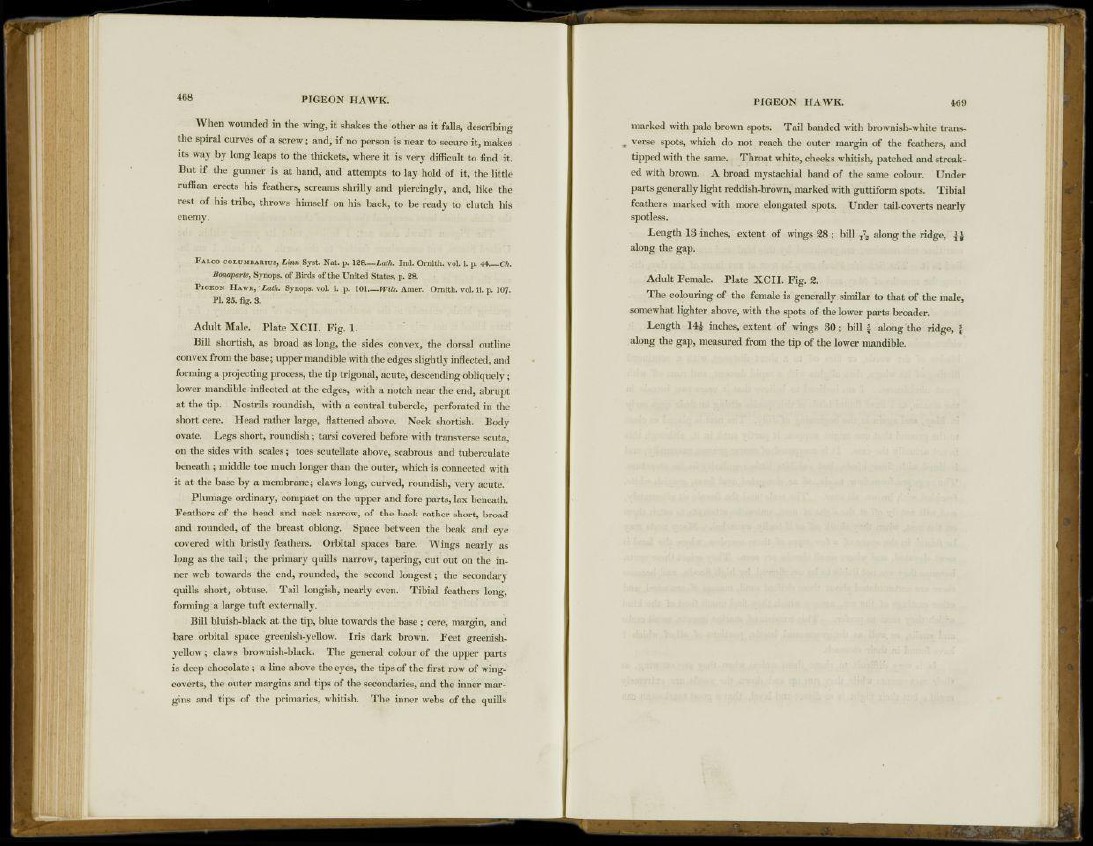
468 PIGEON HAWK.
When wounded in the wing, it shakes the other as it falls, describing
the spiral curves of a screw; and, if no person is near to secure it, makes
its way by long leaps to the thickets, where it is very difficult to find it.
But if the gunner is at hand, and attempts to lay hold of it, the little
ruffian erects his feathers, screams shrilly and piercingly, and, like the
rest of his tribe, throws himself on his back, to be ready to clutch his
enemy.
FALCO COLUMBARIUS, Linn Syst. Nat. p. 128—Lalh. Ind. Ornith. vol. i. p. 44.—Ch.
Bonaparte, Synops. of Birds of the United States, p. 2 8 .
PIGEON HAWK, Lath. Synops. vol. i. p. 101.— Wils. Amer. Ornith. vol. ii. p. 107.
PI. 25. fig. 3.
Adult Male. Plate XCII. Fig. 1.
Bill shortish, as broad as long, the sides convex, the dorsal outline
convex from the base; upper mandible with the edges slightly inflected, and
forming a projecting process, the tip trigonal, acute, descending obliquely ;
lower mandible inflected at the edges, with a notch near the end, abrupt
at the tip. Nostrils roundish, with a central tubercle, perforated in the
short cere. Head rather large, flattened above. Neck shortish. Body
ovate. Legs short, roundish; tarsi covered before with transverse scuta,
on the sides with scales; toes scutellate above, scabrous and tuberculate
beneath ; middle toe much longer than the outer, which is connected with
it at the base by a membrane; claws long, curved, roundish, very acute.
Plumage ordinary, compact on the upper and fore parts, lax beneath.
Feathers of the head and neck narrow, of the back rather short, broad
and rounded, of the breast oblong. Space between the beak and eye
covered with bristly feathers. Orbital spaces bare. Wrings nearly as
long as the tail; the primary quills narrow, tapering, cut out on the inner
web towards the end, rounded, the second longest; the secondary
quills short, obtuse. Tail longish, nearly even. Tibial feathers long,
forming a large tuft externally.
Bill bluish-black at the tip, blue towards the base; cere, margin, and
bare orbital space greenish-yellow. Iris dark brown. Feet greenishyellow
; claws brownish-black. The general colour of the upper parts
is deep chocolate ; a line above the eyes, the tips of the first row of wingcoverts,
the outer margins and tips of the secondaries, and the inner margins
and tips of the primaries, whitish. The inner webs of the quills
PIGEON HAWK. 469
marked with pale brown spots. Tail banded with brownish-white transverse
spots, which do not reach the outer margin of the feathers, and
tipped with the same. Throat white, cheeks whitish, patched and streaked
with brown. A broad mystachial band of the same colour. Under
parts generally light reddish-brown, marked with guttiform spots. Tibial
feathers marked with more elongated spots. Under tail-coverts nearly
spotless.
Length 13 inches, extent of wings 28 ; bill T
7
2 along the ridge, \ \
along the gap.
Adult Female. Plate XCII. Fig. 2.
The colouring of the female is generally similar to that of the male,
somewhat lighter above, with the spots of the lower parts broader.
Length 14£ inches, extent of wings 30; bill £ along the ridge, f
along the gap, measured from the tip of the lower mandible.